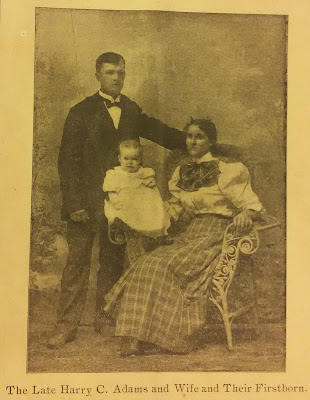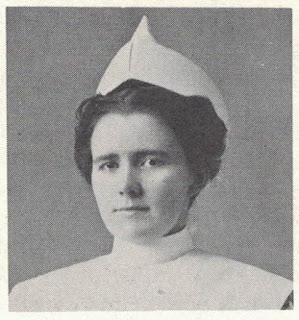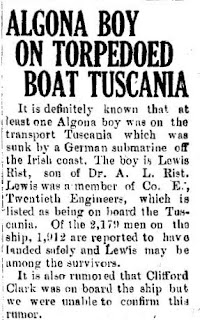Nancy
Yeoman, a good friend and researcher,
emailed me some articles she had come across while researching another matter
that she thought might make good topics for blog posts. I have to agree (and I am glad that someone
else gets distracted from the research project at hand whenever another
headline catches their eye and lures them in).
This particular story is a tale of love and marriage, unhappiness and
parting, murder and suicide—a difficult story to tell, but a reminder that
violence is not new to our society.
THEIR STORY BEGINS
Etta
Campbell and Harry Adams were married November 25, 1895, at the home of Etta’s
father, Zane Campbell. The Campbells
farmed just north of Woden in Grant Township, Winnebago County. The two met when Harry was working for a crew
putting up hay in the area. He had grown
up in Algona, the son of Mr. and Mrs. William Adams, long-time residents who
lived south of town.
The
couple went on to have two daughters, Dora and Vera, and to all outward
appearances, the marriage was a happy one.
Harry was a hard working young man despite a handicap. Caught in a cyclone while living on the farm,
his right arm had been badly broken. Due to the manner in which it was set, after
it healed it was shorter and a little crooked.
This disadvantage did not slow him down though as he had jobs haying,
driving teams, picking corn and cutting wood.
The nature of the work he performed was that of a laborer and it appears
that the family may have struggled financially to some extent.
TROUBLES SURFACE
As
we all know, appearances can be deceiving as no one knows what goes on behind
closed doors. The couple became
estranged at some point and so by September of 1902, Etta Adams decided to
leave her husband and children and did so in a way that caused criminal charges
and public embarrassment.
Her
intention was to leave town and quietly make her way to Elmore, Minnesota,
where she intended to find a job.
Sometime prior to her planned sole departure, she met a young girl by
the name of Loretta Phillips who for whatever reason wanted to run away from
home. Etta consented to take her along
even though she was only 13 years of age. Etta hired a driver by the name of
Joe Fraser to take them to Elmore, Minnesota.
Leaving
Algona on Monday, September 8, 1902, they traveled on back roads mostly at
night to avoid being found. During the
day they would rest at hay stacks to avoid detection. They reached Ledyard on Thursday, September
11th. It was there that
Marshal Fred Jenks spotted them, having been alerted of outstanding warrants
for the two adults. He arrested both
Etta Adams and Joe Fraser who were charged with enticing away a child under the
age of 14. The three were transported to
Algona by the 2 o’clock train. All three
appeared before Justice of the Peace Raymond.
Loretta was sent home to her parents and bond was set at $200 each for
the two adults. While in the court room,
it was observed that none of the three seemed much concerned, especially Etta
who chewed gum during the entire proceeding.
She did declare in open court that she never would go back to live with
her husband again. Shortly thereafter, her
bond was posted by Harry and she did return to live with him.
In
an affidavit filed the following week in the case against her, Etta stated that
she had been having trouble with her husband because he got drunk and abused
her. She stated that she had told him
that she was going to leave him. Her
affidavit, along with similar statements from Loretta, Loretta’s mother, Joe Fraser
and Harry Adams, stated that neither Etta nor Joe enticed Loretta to leave her
home and that she had accompanied Etta of her own free will. All charges were dismissed against both Etta
and Joe, but the damage had been done to their reputations.
SEPARATION AND A DIRE DECISION
Although
they had reconciled, the young couple continued to have problems. They were living in a house near the
Milwaukee depot and Harry was making $35 per month working for the Algona
Milling and Grain Company delivering coal.
Following the incident involving her arrest, Etta declared that the
whole town was gossiping about her and she wanted to move. Harry agreed, quit his job and sold off their
furniture and belongs in preparation for the move. Etta announced that she was leaving to look
for a more desirable location. She then
left without telling Harry where she was going.
It is not known how much time passed, but eventually Etta was spotted in
Fairmont and Harry went there immediately.
He brought her back to Algona where they rented a small home in the
western part of town. Etta was still
restless and unhappy. It was intimated
that male callers came to her home while Harry was at work.
On
Thursday, December 18th, Cora Whitson came to call. Mrs. Whitson had quite a reputation as she,
along with Blanch Ferguson, had been charged with prostitution the previous
year and had been run out of town. Cora
had just recently returned. How these
two women met or formed a friendship is unknown, but they both must have been
hungry for some adventure. They hatched
a plan to meet the next evening. With
her husband gone chopping wood for Ambrose Call, as soon as Etta had her two
small daughters tucked in bed on Friday evening, she left. Upon his arrival home and finding his wife
gone, Harry woke his children asking where their mother had gone. They stated that she had gone off with
“jingle bells.” Knowing his daughters
used that term for the sound of sleigh bells, he took off for the livery stable
where he found the two women preparing to leave. Adams begged his wife to return home, but she
rebuffed him and swore at him. Etta set
off with Cora and didn’t return until 2 a.m.
Where they had been and what they had done was unknown but upon her
return Adams packed up his two little girls and all of the belongings he could
carry and made his way to the home of his parents.
Harry
met with Cora several times over the next few days, begging her to come back
and offering his forgiveness. He asked
to take her to see her parents for Christmas, but she refused, saying they all
could go to hell and that she did not care for Harry or them. After the final rejection, it appears that
Adams decided that if reconciliation was not possible, he would bring a
conclusion to his suffering by ending both of their lives.
DAY OF RECKONING
Harry
and his daughters were living with his parents whose home was south of town
across the river. Etta moved in with
Cora Whitson who was living with her two small children in a couple of small
dirty rooms in the old college building which had been turned into a rooming
house after its move to the corner of Dodge and Nebraska streets. It was there that Harry came with his shotgun
on his shoulder after having Christmas dinner with his family and writing his
suicide note.
 |
| The site today where the old college building sat in 1902 |
He
confronted her one more time asking that she come home and change her mode of
living, but she refused. The two began
to argue loudly and Mrs. Whitson looked in to see that Adams had his wife on
the floor and was hitting her. Etta cried out, “Harry I will go home if you let
me loose.” A moment later Whitson heard
a shot and again looked in to see Etta lying face downward on the bed, shot to
death. She ran to get help and then
heard a second shot. When she returned
she saw Harry’s dead body sprawled on the floor.
The
news articles of the day were quite graphic in their description of the bodies
and the crime scene, leaving little to the imagination. The suicide note was printed in the newspaper
in its entirety including his last words to his children: “Poor
little Vera and Dora. I hate to leave
you.”
Harry’s
body was taken to his parents’ home where a funeral was conducted by Rev. R. T.
Chipperfield the following day. He was
buried in Riverview Cemetery. Etta’s
father, brother James, and brother-in-law Dick Gibson came down from
Woden. They took her remains on the
midnight train as far as Burt where they had a team waiting for them. By early Saturday morning Cora Whitson had
also left town.
Newspapers
often took advantage of tragedies such as these to wax eloquently on moral
turpitude and this instance was no different.
In the January 2, 1903 edition of the Algona Courier, the following was
written:
“It
would be difficult to imagine a scene from which a more impressive lesson could
be drawn as to the value of virtue and right living than the scene of that
tragedy. The dirty little room; the two
mutilated bodies; the spattered blood and brains; the wretched woman who was to
some extent to blame for the extinction of the two lives in another dirty room
with her dirty little children huddled about a stove. It was such a place that Mrs. Adams preferred
to her own humble home. It has been
truly said that virtue is its own reward.
No matter how poor the home is if fidelity and virtue abide there it may
be in a measure happy. Its occupants may
have approving consciences and self respect and the respect of others. Even in dire poverty children may be reared
to reverence religion, truth and virtue and conscious of the rectitude of their
lives they become strong, self respecting and wholesome members of
society. But in households where there
is no religion or moral training there is seldom virtue and the ornaments which
it bestows.
“Young
women and young men too should be warned by the fate of Mrs. Adams and her
husband and also by the fate of Mrs. Whitson and Mrs. Ferguson and all such
unfortunates. When the jewel of virtue
is lost womanhood is degraded too low for contemplation. Let her who would be happy, respected and
love preserve that jewel from stain as she would preserve her life from danger.”
Until next time,
Jean
If you enjoyed this
post, please don’t forget to “like” and SHARE to Facebook. Not a Facebook user? Sign up with your email address in the box on
the right to have each post sent directly to you.
Be sure to visit the
KCHB Facebook page for more interesting info about the history of Kossuth
County, Iowa.
Reminder: The posts on Kossuth County History Buff are ©2015-2017 by Jean Kramer. Please use
the FB “share” feature instead of cutting/pasting.

















